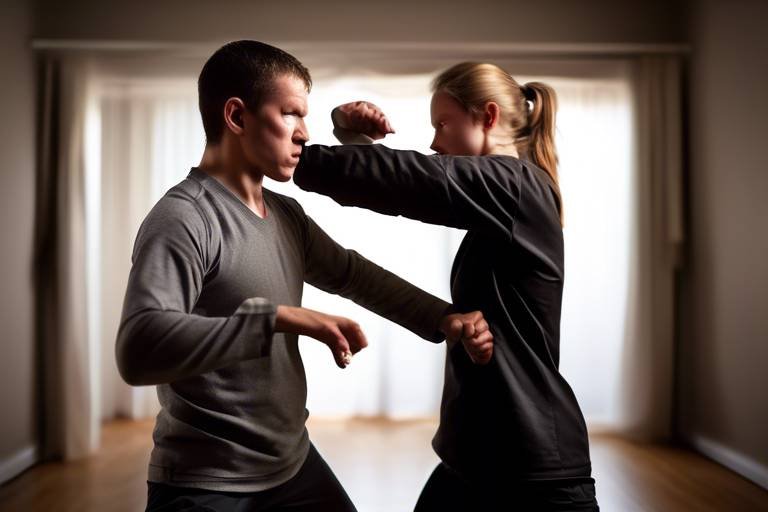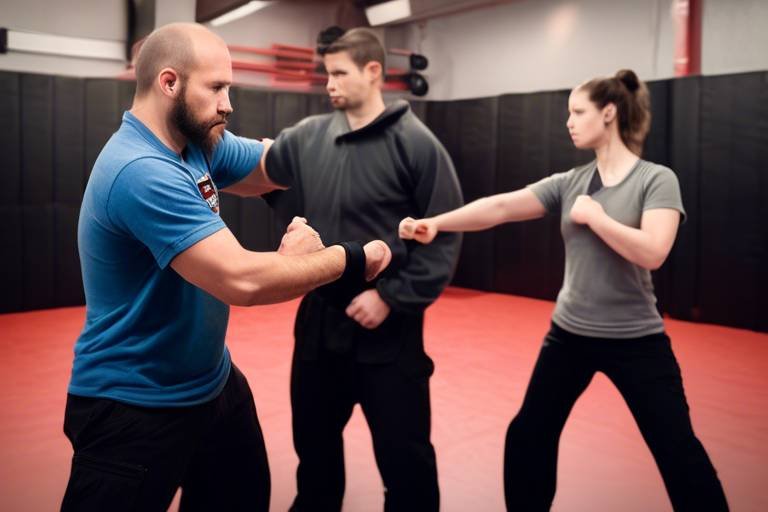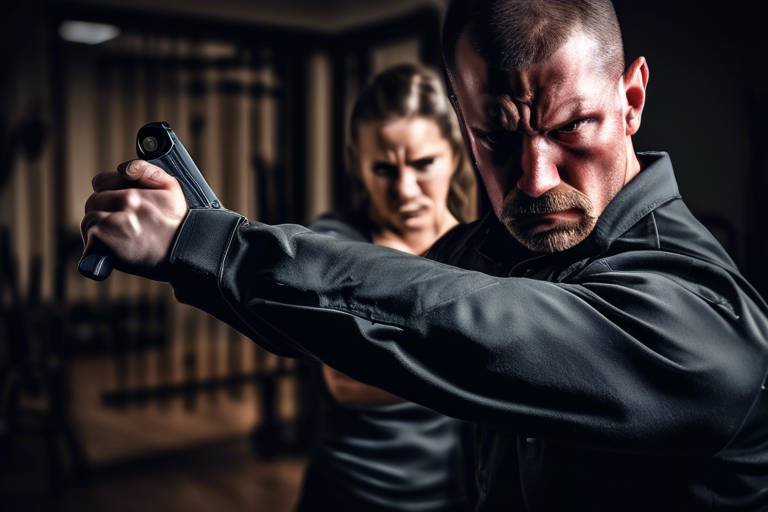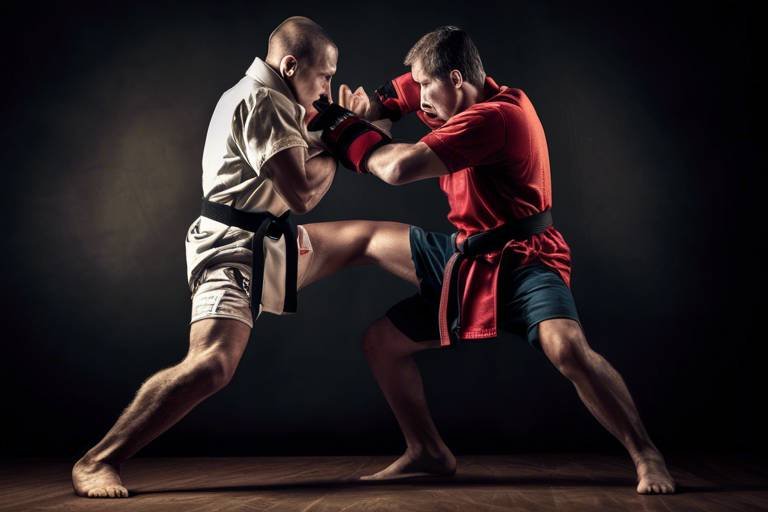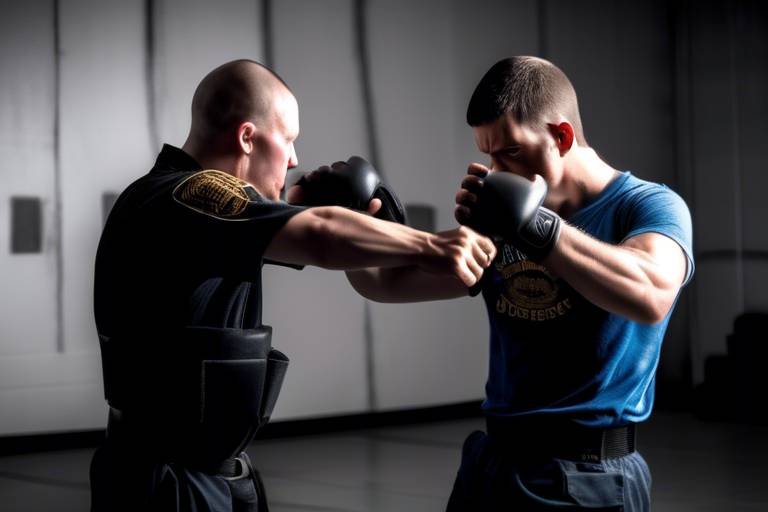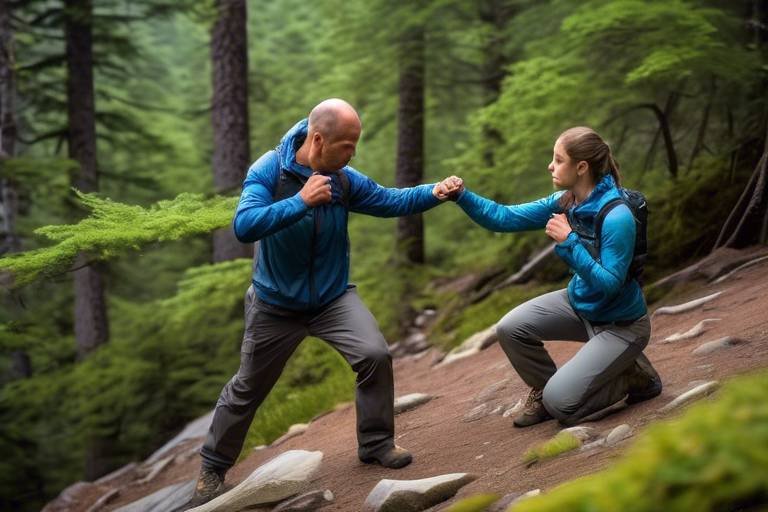Safe Techniques to Practice Self-Defense at Home
In a world where personal safety is paramount, knowing how to protect yourself is not just a skill; it's a form of empowerment. Practicing self-defense at home can be both a fun and rewarding experience. It allows you to build confidence, enhance your physical fitness, and prepare for any unexpected situations. But how do you start? What techniques can you safely practice in the comfort of your own space? In this article, we will explore various self-defense techniques that can be practiced safely at home, empowering you to protect yourself and enhance your confidence in personal safety scenarios.
Before diving into techniques, it's crucial to understand the principles of self-defense. Self-defense isn't just about fighting back; it's also about understanding the legal implications of your actions. You must be aware that the law often views self-defense as a last resort. The best way to avoid confrontation is through awareness and avoidance. This means being alert to your surroundings, recognizing potential threats, and knowing when to disengage. After all, the goal is to stay safe, not to escalate a situation.
Creating a designated space for practice is essential. Choose an area in your home where you can move freely without the risk of injury or damaging property. This could be a living room, basement, or even a backyard. Ensure the space is clear of obstacles, and consider adding some basic equipment to facilitate effective self-defense training. Items such as a punching bag, focus mitts, or even a sturdy chair can be excellent tools for practicing techniques safely. Remember, safety first!
Mastering the fundamental stances and movements is crucial as they form the foundation of self-defense techniques. These basics enhance your agility and readiness during a confrontation. Start by practicing a solid stance: feet shoulder-width apart, knees slightly bent, and hands up in a guard position. This stance not only protects your face but also prepares you to move quickly in any direction. The right stance can be the difference between evading an attack and being caught off guard.
Effective footwork is vital in self-defense. It allows you to maintain balance, mobility, and positioning during an altercation. Practice moving in various directions—forward, backward, and side to side. Quick, light steps can help you evade attacks while keeping you ready to counter. Think of your feet as your foundation; if your foundation is strong, everything else will follow. Regular practice of these techniques will not only improve your self-defense skills but also enhance your overall fitness.
Understanding body mechanics is crucial for maximizing power and efficiency in movements. When executing techniques, focus on using your entire body rather than just your arms or legs. For example, when throwing a punch, engage your core and pivot your hips to generate more force. This principle applies to kicks as well—using your hips and legs in unison will help you deliver powerful strikes. Remember, it’s not just about strength; it’s about technique!
Now that you've grasped the basics, let’s delve into some key self-defense techniques that can be practiced at home. These techniques are simple yet effective, making them suitable for individuals of all skill levels. Whether you’re a beginner or have some experience, these maneuvers can be adapted to fit your comfort level.
Striking techniques are fundamental in self-defense. Practicing punches and kicks can significantly develop your strength and precision. Start with basic punches like jabs and crosses, focusing on form and accuracy. As you gain confidence, incorporate kicks—front kicks, roundhouse kicks, and side kicks are great options. Remember, the goal is not just to strike but to strike effectively and with purpose.
Defensive maneuvers are crucial for protecting oneself. Techniques such as blocking and evading attacks ensure that you can respond effectively in threatening situations. Practice blocking punches with your forearms and learning how to sidestep or duck can make a significant difference. Think of these maneuvers as your shield; they help you deflect danger while keeping you in control.
Integrating self-defense practice into your daily routine enhances muscle memory and confidence. Consider setting aside a few minutes each day to practice the techniques you've learned. Whether it's during a break at work or while watching TV, finding small pockets of time can lead to significant improvements. The more you practice, the more instinctive your responses will become. It’s like building a habit; the more you do it, the easier it gets!
Q: Do I need any special equipment to practice self-defense at home?
A: While you can practice many techniques without equipment, items like a punching bag or focus mitts can enhance your training experience. Just ensure your practice area is safe.
Q: How often should I practice self-defense techniques?
A: Consistency is key! Aim to practice a few times a week, even if it's just for a short duration. Regular practice helps build muscle memory and confidence.
Q: Can self-defense techniques be effective for everyone?
A: Yes, self-defense techniques can be adapted for individuals of all ages and fitness levels. The focus should always be on using your strengths and practicing techniques that feel comfortable for you.

Understanding Self-Defense Basics
Before diving into the exciting world of self-defense techniques, it’s essential to grasp the fundamentals that underpin these skills. Self-defense isn't just about throwing punches or executing fancy moves; it's a complex blend of awareness, legal considerations, and strategic avoidance. Imagine walking through a crowded market; your first line of defense is being aware of your surroundings. This awareness can help you avoid potentially dangerous situations before they escalate.
Now, let’s talk about the legal implications. Self-defense laws can vary significantly depending on where you live. In some places, you can use reasonable force to protect yourself, while in others, the laws may be stricter. It’s crucial to familiarize yourself with the laws in your area, as using excessive force can lead to serious legal consequences. Understanding these laws is like having a roadmap; it guides you in making the right decisions when faced with a threat.
Furthermore, self-defense is not only about physical techniques; it’s also about mental preparedness. Think of it this way: your mind is like a muscle that needs training too. When you practice self-defense, you're not just learning how to fight; you're also training yourself to remain calm and collected under pressure. This mental state can be your best ally in a tense situation. Here are a few mental strategies to consider:
- Stay Calm: Panic can cloud your judgment. Practice techniques that help you breathe and stay focused.
- Assess the Situation: Quickly evaluate the environment and potential escape routes.
- Know Your Options: Be aware of both verbal and physical responses you can employ.
In essence, self-defense is about empowering yourself. It’s about building confidence and developing a mindset that prioritizes safety. Remember, the goal is to protect yourself and avoid confrontation whenever possible. Think of self-defense as a toolkit—the more tools you have, the better equipped you are to handle unexpected situations. By understanding these basics, you lay a solid foundation for the techniques that will follow.
So, as we move forward in this article, keep in mind that effective self-defense starts with a strong understanding of these principles. They will guide you as you learn the physical skills necessary to protect yourself. And remember, the best fight is often the one you avoid altogether!

Setting Up a Safe Practice Space
Creating a safe practice space at home is an essential step in your journey to mastering self-defense techniques. Think of your practice area as your personal dojo, a sanctuary where you can hone your skills without distractions or hazards. The first thing you need to consider is the location. Ideally, choose a room with ample space, such as a living room or a basement, where you can move freely without bumping into furniture or other obstacles. A clutter-free environment not only enhances safety but also allows you to focus entirely on your training.
Next, let's talk about equipment. While you don’t need a lot to get started, having some basic items can significantly enhance your practice sessions. Here’s a quick rundown of the essentials:
- Training Mat: A soft surface helps prevent injuries during falls or ground techniques.
- Heavy Bag: This is great for practicing striking techniques, allowing you to develop power and accuracy.
- Mirror: A full-length mirror can help you monitor your form and technique as you practice.
Now, let’s think about lighting and ventilation. Good lighting is crucial; you want to see yourself clearly as you practice your moves. Natural light is ideal, but if that’s not possible, invest in bright LED lights. Ventilation is equally important—ensure that the space is well-aired to keep you comfortable during your workouts. A stuffy room can lead to fatigue and distract you from your training.
Another aspect to consider is sound. You might want to play some motivating music or sounds that help you focus, but be mindful of the volume. Too loud, and you risk disturbing others in your household; too quiet, and you might miss important cues during your practice. Finding a happy medium is key.
Finally, don’t forget about personal safety. Always inform someone in your household when you’re practicing, especially if you’re working on techniques that could be risky. It’s also a good idea to have a phone nearby in case of emergencies. Remember, the goal is to empower yourself through self-defense, not to put yourself in a potentially dangerous situation.
In conclusion, setting up a safe practice space is about more than just having enough room; it’s about creating an environment where you can confidently explore and develop your self-defense skills. By focusing on location, equipment, lighting, ventilation, sound, and personal safety, you’ll be well on your way to becoming a self-defense pro right in the comfort of your home.

Basic Stances and Movements
When it comes to self-defense, the foundation lies in mastering . Think of it as building a house; without a strong foundation, everything else can crumble. These stances not only enhance your balance and readiness but also prepare you for effective movement in any situation. It's essential to feel comfortable and confident in your stance, as this can significantly impact your ability to react during a confrontation.
One of the most fundamental stances is the fighting stance. This stance involves positioning your feet shoulder-width apart, with one foot slightly forward. Your knees should be slightly bent, allowing you to maintain balance and quickly pivot or move. Keep your hands up near your face, ready to defend yourself. Imagine you're a boxer in the ring—this stance is your shield against incoming threats.
Another important stance is the defensive stance. This stance is similar to the fighting stance but focuses more on protection. In this position, you should lean slightly back, keeping your weight on your back foot. This allows you to evade attacks while maintaining the ability to counter. Think of it as a cat poised to leap; you're ready to spring into action at a moment's notice.
In addition to stances, mastering basic movements is crucial. You want to be agile and ready to respond quickly. Shuffling is an excellent movement technique that involves sliding your feet while maintaining your stance. This helps you reposition without losing balance or stability. Picture a dancer gliding across the floor; that's the kind of fluidity you want to achieve.
Moreover, practicing turning movements is essential. Being able to pivot quickly can help you face an attacker from any angle. To practice, stand in your fighting stance and rotate your body while keeping your feet planted. This will help you develop the necessary muscle memory for quick reactions in a real-life situation.
Finally, don’t underestimate the power of breathing techniques. Staying calm and collected is vital in any self-defense scenario. Practice deep breathing while in your stances to maintain focus and reduce anxiety. Think of it as your internal anchor amidst the chaos; it keeps you grounded and ready to act.
In summary, mastering basic stances and movements is not just about physical readiness; it's about building confidence and awareness. The next time you practice, remember that these fundamentals are your first line of defense. So, get comfortable, practice regularly, and soon you'll find that these techniques become second nature.
- How often should I practice my stances and movements? Aim for at least 15-30 minutes a few times a week to build muscle memory.
- Can I practice self-defense techniques alone? Yes, many techniques can be practiced solo, but consider joining a class for hands-on experience.
- What if I don't have a lot of space at home? You can practice in small areas; just focus on your footwork and body mechanics.

Footwork Techniques
When it comes to self-defense, footwork is often the unsung hero. Imagine a dancer on stage; their movements are fluid, precise, and calculated. In self-defense, your footwork serves a similar purpose—it allows you to maneuver effectively, maintain balance, and position yourself advantageously during a confrontation. So, how do you master this crucial aspect of self-defense? Let's break it down.
First off, it’s essential to understand that good footwork can make all the difference between escaping a situation and being caught off guard. Think of your feet as the foundation of a house; if they're not stable, everything else is at risk. Here are some fundamental footwork techniques that you can practice at home:
- Basic Stance: Start with your feet shoulder-width apart and knees slightly bent. This stance provides a solid base for movement.
- Shifting Weight: Practice shifting your weight from one foot to the other. This technique prepares you for quick movements in any direction.
- Side Steps: Move sideways while maintaining your stance. This lateral movement helps you evade attacks and reposition yourself.
- Forward and Backward Movement: Practice stepping forward and backward. This not only helps you close the distance but also allows you to retreat when necessary.
Now, let’s dive deeper into the importance of balance and mobility. Balance is your best friend in a self-defense scenario. If you’re off-balance, you’re vulnerable. To improve your balance, try practicing standing on one foot while moving your arms in various directions. This will help you develop stability and control.
Mobility is equally important. The quicker you can move, the better your chances of avoiding an attack or executing a counter-move. To enhance your mobility, incorporate exercises like skipping or ladder drills into your routine. These activities not only build agility but also improve your overall fitness, making you more prepared for any situation.
Another vital aspect of footwork is the concept of distance management. In a self-defense scenario, understanding the distance between you and your attacker can be a game-changer. You want to be close enough to strike but far enough to evade an attack. Practice moving in and out of range to get a feel for what works best for you.
As you practice these footwork techniques, remember that repetition is key. Just like learning to ride a bike, the more you practice, the more instinctual these movements will become. Consider setting aside a few minutes each day to focus solely on footwork. You’ll be surprised at how quickly you improve!
In summary, mastering footwork techniques is essential for effective self-defense. By focusing on basic stances, weight shifting, and distance management, you'll build a strong foundation that enhances your overall self-defense skills. So, lace up those shoes and get moving—your safety may depend on it!
Q: How often should I practice footwork techniques?
A: Aim for at least 10-15 minutes a day to build muscle memory and improve your skills.
Q: Can I practice footwork in a small space?
A: Absolutely! You can practice basic footwork in your living room or even outside in your yard. Just ensure you have enough room to move safely.
Q: Is footwork important for all self-defense techniques?
A: Yes, effective footwork is crucial for all self-defense techniques, as it helps you maintain balance, evade attacks, and position yourself for strikes.

Body Mechanics
Understanding is essential for anyone looking to enhance their self-defense skills. It’s not just about throwing punches or kicks; it’s about how you use your entire body to generate power, maintain balance, and ensure efficiency in your movements. Imagine your body as a well-tuned machine; every part needs to work together harmoniously to achieve the best results. When you grasp the principles of body mechanics, you can maximize your strength and minimize the risk of injury.
One of the fundamental aspects of body mechanics in self-defense is the concept of alignment. Proper alignment ensures that your body is in the best position to execute techniques effectively. This involves keeping your spine straight, shoulders relaxed, and hips aligned with your feet. When your body is aligned, you can transfer energy more efficiently from your legs through your core to your arms. Think of it as a chain reaction—when one link is strong and properly positioned, the entire chain is more effective.
Another critical element is the use of kinetic energy. This is the energy of motion, and in self-defense, it’s all about using your body’s weight and momentum to your advantage. For instance, when delivering a punch or kick, you should not only rely on your arm or leg strength. Instead, engage your entire body by pivoting on your feet and rotating your hips. This technique not only adds power to your strikes but also helps in maintaining balance. Picture a baseball pitcher; their entire body moves to create a powerful throw, and you should adopt a similar approach.
Practicing body mechanics can also improve your reaction time. When you’re aware of how your body moves, you can respond more quickly to an attack. This involves not just the physical aspect but also mental awareness. Visualizing your movements and understanding how to shift your weight can prepare you for real-life situations. It’s like playing chess—anticipating your opponent’s next move and positioning yourself accordingly can make all the difference.
To further illustrate these concepts, let’s consider a few key body mechanics principles:
| Principle | Description |
|---|---|
| Weight Distribution | Keep your weight centered and balanced to allow for quick movements and stability. |
| Core Engagement | Engaging your core muscles provides strength and stability for all movements. |
| Breathing Techniques | Breathing properly can help maintain stamina and control during practice. |
Incorporating these principles into your training will lead to a more effective self-defense practice. Remember, it’s not just about knowing how to strike; it’s about knowing how to move. Consistent practice of body mechanics will not only enhance your self-defense capabilities but also build your confidence. The more you understand your body and how it operates, the more prepared you’ll be to handle unexpected situations.
- What are body mechanics in self-defense? Body mechanics refer to the way you move and position your body to enhance strength, balance, and efficiency in self-defense techniques.
- Why is body alignment important? Proper alignment helps in transferring energy effectively, reducing the risk of injury, and maximizing the power of your strikes.
- How can I improve my reaction time? Practicing your movements with awareness and understanding weight shifts can help improve your reaction time in self-defense scenarios.

Essential Self-Defense Techniques
When it comes to self-defense, having a solid grasp of essential techniques can make all the difference in a tense situation. These techniques are not just about physical strength; they are about strategy, awareness, and the ability to react quickly. Whether you’re a beginner or someone with a bit more experience, mastering these fundamental self-defense moves can empower you and boost your confidence. Remember, self-defense is about creating an opportunity to escape rather than engaging in prolonged confrontation.
Let’s dive into some key self-defense techniques that can be practiced right at home. First and foremost, **striking techniques** are essential. These are the moves that can help you create distance between yourself and an attacker. Think of them as your first line of defense. You can practice various types of strikes, including:
- Punches: These can be straightforward jabs or more powerful hooks. Practicing your punches on a heavy bag or even shadowboxing can enhance your strength and precision.
- Kicks: Kicking can be an effective way to keep an aggressor at bay. Front kicks and side kicks are particularly useful for creating space.
Another crucial aspect of self-defense is **defensive maneuvers**. These techniques allow you to protect yourself while minimizing the risk of injury. Think of them as your shields in a confrontation. Here are a few defensive moves you should familiarize yourself with:
- Blocking: This involves using your arms and hands to deflect incoming strikes. It’s important to practice different blocking techniques to find what feels most natural to you.
- Evading: Sometimes, the best defense is simply avoiding the attack. Practice moving out of the way quickly, using footwork to reposition yourself.
Incorporating these techniques into your training routine can significantly enhance your self-defense skills. Remember, practice makes perfect! You can even set up a simple practice schedule at home. For instance, dedicate specific days to work on striking techniques and alternate with defensive maneuvers. This consistent practice will help you internalize these techniques, making them second nature when you need them most.
One thing to keep in mind is that self-defense is not just about physical techniques; it’s also about mental preparedness. Staying aware of your surroundings and being able to assess situations quickly can often prevent confrontations from escalating in the first place. So, as you practice these techniques, also consider incorporating situational awareness exercises into your routine.
To wrap it up, mastering essential self-defense techniques is about more than just learning moves; it’s about building a mindset of confidence and readiness. The world can be unpredictable, but with the right techniques and a proactive approach, you can feel empowered and prepared to handle any situation that comes your way.
Q: Do I need to be physically strong to practice self-defense?
A: Not at all! Self-defense techniques focus on leverage, timing, and strategy rather than brute strength. Anyone can learn effective self-defense with practice.
Q: How often should I practice self-defense techniques?
A: Regular practice is key. Aim for at least a couple of sessions each week, focusing on different techniques to ensure well-rounded skills.
Q: Can self-defense techniques be used in all situations?
A: Self-defense techniques should always be used as a last resort. The goal is to escape safely, not to engage in a fight. Always assess the situation first.
Q: Is it necessary to take a class to learn self-defense?
A: While classes can provide valuable instruction and feedback, you can also learn a lot through dedicated practice at home. Just ensure you’re practicing safely!

Striking Techniques
When it comes to self-defense, mastering is not just about throwing punches or kicks; it's about developing the confidence and skill to respond effectively in a threatening situation. These techniques are your first line of defense, and they can make a significant difference in your ability to protect yourself. Imagine being in a situation where you need to defend yourself—having the knowledge of effective strikes can empower you to take control of the encounter.
One of the most fundamental striking techniques is the jab. This quick, straight punch is not only effective for creating distance but also for gauging your opponent's reach and reaction. To throw a proper jab, keep your elbow in and extend your arm straight out, rotating your fist as you make contact. This technique can be practiced against a heavy bag or even with a partner, ensuring you develop both speed and accuracy.
Another crucial strike is the cross, which is a powerful punch thrown with your dominant hand. The cross follows the jab and can catch an opponent off guard, especially if you’ve established a rhythm with your jabs. To execute a cross, pivot your back foot while rotating your hips and shoulders, allowing your body to generate force. Practicing this technique will help you learn how to channel your body’s energy into your strikes, making them more impactful.
In addition to punches, incorporating kicks into your self-defense arsenal is essential. The front kick is a versatile technique that can be used to keep an opponent at bay. To perform a front kick, lift your knee while extending your foot forward, striking with the ball of your foot. This technique is not only effective for self-defense but also helps improve your balance and flexibility.
To ensure you are practicing effectively, consider the following tips:
- Warm-Up: Always start with a proper warm-up to prevent injuries.
- Focus on Form: Prioritize technique over speed or power in the beginning.
- Use Equipment: Incorporate a punching bag or focus mitts to enhance your training.
As you practice these striking techniques, remember that repetition is key. Just like learning to ride a bike, the more you practice, the more natural it will become. You can even incorporate drills into your daily routine—perhaps during a break or while watching TV. This not only makes practice more enjoyable but also helps in building muscle memory.
In conclusion, striking techniques are a vital aspect of self-defense. They provide you with the skills to defend yourself effectively and confidently. By dedicating time to practice these techniques at home, you’re not just preparing for a confrontation; you’re empowering yourself with the knowledge and skills to handle unexpected situations. So, lace up those training shoes, find a safe space, and start practicing your strikes today!
Q: Do I need prior experience to practice striking techniques?
A: No prior experience is necessary! Striking techniques can be learned by anyone, and starting with the basics is a great way to build your skills.
Q: How often should I practice these techniques?
A: Consistency is key! Aim to practice at least two to three times a week to see significant improvement.
Q: Can I practice striking techniques alone?
A: Yes, many techniques can be practiced solo using a mirror or a heavy bag. However, practicing with a partner can enhance your skills even further.

Defensive Maneuvers
Defensive maneuvers are the backbone of self-defense, providing essential techniques to protect oneself during a confrontation. Imagine being in a situation where an aggressor approaches you; the first instinct is often to panic. However, understanding and mastering defensive maneuvers can turn that panic into a calculated response. These techniques not only help you shield yourself from attacks but also give you the confidence to handle unexpected situations. The key is to remain calm and focused, using your body effectively to create distance and protect vital areas.
One of the most fundamental defensive maneuvers is the block. This technique involves using your arms or hands to intercept an incoming strike. For instance, when a punch is thrown at you, raising your forearm to deflect the blow can minimize damage and create an opening for your counterattack. Similarly, evading is another critical maneuver. This technique requires you to move your body out of the line of attack, often by stepping to the side or ducking. Think of it as a dance; the goal is to move gracefully away from danger while maintaining your balance and readiness to respond.
To practice these defensive maneuvers effectively, consider setting up a training routine that includes various scenarios. For instance, you can practice blocking against a partner's strikes or simulate an attack using a padded bag. This will help you develop timing and accuracy in your responses. It's also beneficial to incorporate footwork into your drills, as being mobile can significantly enhance your defensive capabilities. Remember, the more you practice, the more instinctive these movements will become.
Additionally, understanding the concept of distance management is crucial in defensive maneuvers. Maintaining the right distance from your opponent can prevent them from landing a hit while allowing you to react appropriately. Here’s a simple table to illustrate the different ranges you should be aware of during a confrontation:
| Distance | Description | Recommended Maneuvers |
|---|---|---|
| Close Range | Within arm's reach; potential for immediate strikes. | Blocking, clinching, or close-range strikes. |
| Medium Range | Just out of reach; allows for movement. | Evading, lateral footwork, and jabs. |
| Long Range | Far enough to avoid immediate danger. | Creating distance, using environment for escape. |
In summary, mastering defensive maneuvers is all about practice, awareness, and confidence. By incorporating these techniques into your self-defense training, you empower yourself to respond effectively in threatening situations. Remember, self-defense is not just about physical techniques; it's also about mental preparedness. Stay alert, trust your instincts, and always be ready to adapt to the circumstances around you.
- What are the most important defensive maneuvers to learn? The most crucial maneuvers include blocking, evading, and distance management, as they help you protect yourself and respond effectively in various situations.
- Can I practice these techniques alone? Yes, many defensive maneuvers can be practiced solo, especially footwork and blocking against a wall or a padded bag.
- How often should I practice self-defense techniques? Regular practice is essential. Aim for at least a few times a week to build muscle memory and confidence.
- Is self-defense training suitable for everyone? Absolutely! Self-defense training can benefit individuals of all ages and fitness levels.

Incorporating Self-Defense into Daily Routine
Integrating self-defense practice into your daily routine is not just about setting aside time for dedicated training; it’s about weaving these vital skills into the fabric of your everyday life. Imagine this: you’re brushing your teeth, and instead of just going through the motions, you can practice your footwork, shifting your weight from one foot to the other, enhancing your balance and mobility. Sounds simple, right? But these little moments can accumulate to make a big difference in your self-defense capabilities.
One effective way to incorporate self-defense into your daily activities is to use everyday situations as opportunities for practice. For instance, while waiting for your coffee to brew, you can perform a few basic stances or practice your striking techniques against a pillow or a soft surface. This not only keeps your skills sharp but also builds muscle memory, making your responses instinctive in real-life situations.
Additionally, consider setting reminders for yourself throughout the day. These can be as simple as a note on your fridge or an alert on your phone. When you see these reminders, take a moment to practice a specific technique or review the principles of self-defense. This consistent reinforcement can significantly enhance your confidence and readiness.
Moreover, you can involve your family or friends in your practice. Turn your self-defense training into a fun and engaging group activity. Have a mini training session in your living room, where you can practice techniques together. Not only does this make the learning process enjoyable, but it also fosters a sense of community and support, which is crucial in self-defense training.
Here’s a quick table to help you visualize how you can incorporate self-defense into your daily routine:
| Activity | Self-Defense Practice |
|---|---|
| Brushing Teeth | Practice footwork and shifting weight |
| Waiting for Coffee | Perform basic stances or strikes against a pillow |
| Watching TV | Practice defensive maneuvers during action scenes |
| Walking the Dog | Focus on situational awareness and body posture |
| Family Time | Have fun practicing techniques together |
By turning mundane tasks into practice opportunities, you not only enhance your skills but also make self-defense a natural part of your life. Remember, the goal is not to become a martial arts expert overnight, but rather to build a foundation that empowers you to feel safe and confident in any situation.
Q: How often should I practice self-defense techniques?
A: Aim to practice at least a few minutes every day. Consistency is key to building muscle memory and improving your skills.
Q: Do I need special equipment to practice self-defense at home?
A: While some equipment can enhance your training (like pads or a punching bag), many techniques can be practiced with just your body and a little creativity.
Q: Can I practice self-defense alone?
A: Absolutely! Many self-defense techniques can be practiced solo, but having a partner can help with certain drills and make practice more enjoyable.
Q: Is self-defense training suitable for everyone?
A: Yes! Self-defense training can be adapted to suit all ages and fitness levels. It’s about finding what works best for you.
Frequently Asked Questions
- What is the best way to start practicing self-defense at home?
The best way to begin is by understanding the basics of self-defense. Start by familiarizing yourself with the principles of awareness and avoidance. Create a safe practice space in your home, ensuring you have enough room to move around freely. Then, focus on mastering basic stances and movements to build a solid foundation.
- Do I need any special equipment to practice self-defense at home?
While you can practice many techniques without equipment, having some basic items can enhance your training. Consider using a punching bag, a mat for ground work, or even a sturdy chair for certain defensive maneuvers. Remember, the goal is to create a safe and effective environment for your practice.
- How often should I practice self-defense techniques?
Consistency is key! Aim to practice at least a few times a week to build muscle memory and confidence. Incorporating self-defense techniques into your daily routine—like shadowboxing during breaks or practicing footwork while watching TV—can make training feel more natural and less daunting.
- Are self-defense techniques safe to practice alone?
Yes, many self-defense techniques can be safely practiced alone. Focus on movements, stances, and footwork that don’t require a partner. However, if you’re trying more advanced techniques or sparring, it’s wise to practice with a partner or under the supervision of a qualified instructor.
- Can self-defense training help with confidence?
Absolutely! Learning self-defense not only equips you with practical skills but also boosts your confidence. As you become more familiar with techniques and improve your physical fitness, you'll feel more empowered in various situations, which can translate into everyday life.
- What should I do if I feel overwhelmed while practicing?
If you ever feel overwhelmed, take a break! Self-defense training should be enjoyable and empowering, not stressful. Focus on one technique at a time and gradually build up your skills. Remember, it’s perfectly okay to take things slow and ask for help when needed.
- Is self-defense training effective for all ages?
Yes, self-defense training can be adapted for individuals of all ages and fitness levels. The techniques can be modified to suit your physical capabilities, making it accessible for everyone from children to seniors. The key is to focus on what works best for you and your body.

